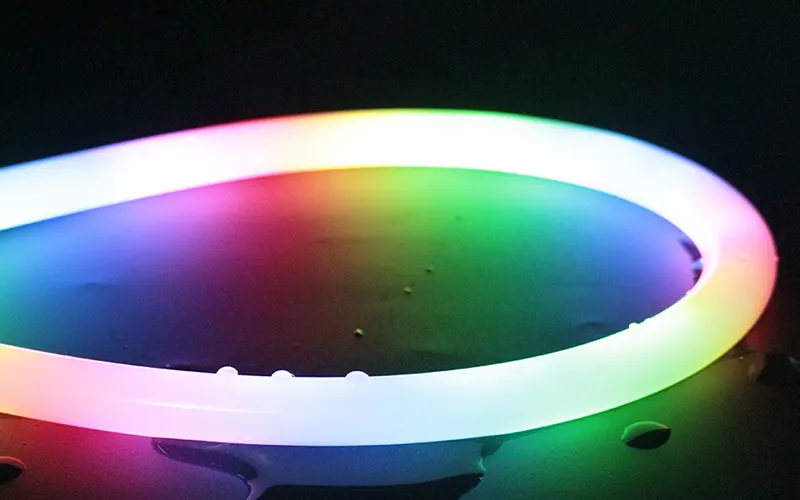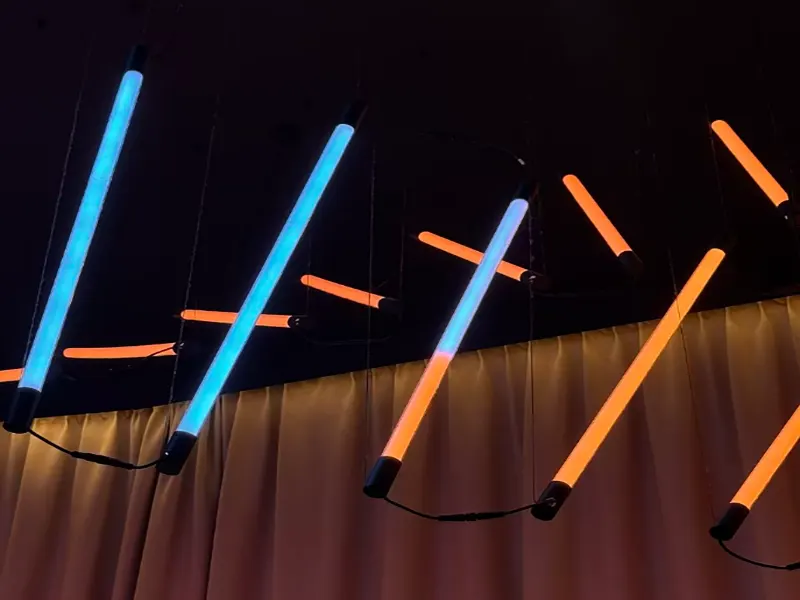In outdoor lighting design and commercial space decoration, IP67 waterproof LED neon flex has become a lighting option that combines both artistic and functional appeal. You can spot them anywhere, whether in cafe signage or as a focal point in branded stores. LED neon lights instantly enhance the quality and personal expression of any space; However, with the two mainstream types of neon lights—360 neon flex and flat neon flex—many consumers often struggle to choose which is best for their project.
These two types of neon lights, 360 LED neon flex and flat neon strips, look completely different. Naturally, there are significant differences in lighting effects, installation methods, applicable scenarios, and cost. Therefore, it’s important to fully understand them to better select the right LED neon tube. If you need know more, pls read A Comprehensive Guide to Neon Strip Lights 2024
What Is a 360 LED Neon Flex?
As the name suggests, a 360° LED neon is a flexible light strip that provides 360-degree illumination. Our 360° neon LED strips are machine-extruded and now meet IP67 waterproof standards.
They perfectly encapsulate high-brightness LEDs within a transparent, flexible silicone tube, allowing light to be evenly transmitted from all angles. They are primarily used for indoor artistic designs and ambient lighting.

360-degree illumination
The most striking feature of 360 LED neon signs is their seamless illumination. This means you’ll see a full, bright beam of light from any angle. The light is perfectly uniform.
Customizable Appearance
Due to its rounded shape and all-angle illumination, it’s ideal for creating 3D shapes, such as lettering, patterns, or any self-contained art installation.
Lighting Innovation
The transparent silicone tubing and surrounding light effects give it a unique technological aesthetic, perfect for modern, avant-garde designs.
Common Installation Methods
It’s typically suspended and supported using transparent clips or hanging cables, allowing it to stand free from the wall and stand independently in a space.
What are Flat Neon Strips?
Flat neon light strips, also known as flat LED light strips or flexible LED outline lights, are decorative lighting products with a simpler structure. More details, pls read What is an LED Neon Flex Lights?
They consist of a row of LED beads soldered onto a flat flexible printed circuit board (FPCB), covered with a layer of milky white silicone. Their overall thin strip shape makes them easy to conceal for installation.
Unlike 360° neon flex lights, flat neon light strips primarily emit light forward, with brightness significantly reduced towards the sides and back, representing a directional light pattern. Therefore, flat neon light strips are more versatile, cost-effective, and easy to install, making them a popular choice for home users and small renovation projects.
360 Neon Flex vs. Flat Neon Strip

In order to give you a more intuitive understanding of the differences between 360-degree neon lights and flat neon tubes, we have summarized the core differences between them by comparing the following details:
| Comparative Dimensions | 360 LED Neon Flex | Flat Neon Strip |
| Lighting Angle | 360° all-around stereoscopic illumination, eliminating blind spots and providing uniform illumination from every angle. | Approximately 120-180°, single-sided illumination with a clearly defined direction and limited illumination angles. |
| Lighting Effects | Luminous three-dimensional, atmospheric lighting with a futuristic feel. | The light provides a soft, even illumination, suitable for many lighting applications. |
| Lighting Applications | 360-degree 3D modeling, freestanding hanging installations, interior decoration. | Used for outlining flat or curved surfaces, backlighting, advertising signs, and more. |
| Installation Method | Requires mounting clips and a hanging fixture for securement. | Directly adhere to the surface using adhesive, most often using clips or profiles for fastening. |
| Space Requirements | Usually used for ceiling lighting, requiring a certain amount of space to display its effect. | 360-degree 3D modeling, freestanding hanging installations, and interior decoration. |
360 Neon Flex vs. Flat Neon Strip: How to Choose?
Now that we’ve understood the core differences between the two types of LED neon light, you can choose the right one based on your specific project needs. Different neon light types have different uses.
360 Neon LED Lighting Projects:
- Creative Projects: You want to create three-dimensional letters, hearts, geometric shapes, or any other shape that needs to be seen from multiple sides.
- Indoor Lighting: You plan to use the strips as a focal point in a space, such as hanging them above a dining room, on a wedding arch, or in the center of an exhibition hall.
- Visibility from All Angles: Your decoration needs to be visible from all angles, front, back, left, and right.
- Innovative Lighting Style: Your interior design theme clearly suggests a modern, sci-fi, or avant-garde style.
Flat Neon Strip Lighting Projects:
- Surface Contouring: You need to apply it along the edges of walls, ceilings, mirrors, or furniture to contour their contours.
- Signs and Signage: It’s a classic and effective choice for creating shop signs, company logos, or wall slogans.
- Ambient Lighting: It can be used as indirect lighting for TV backgrounds, under beds, or under cabinets, creating a soft, ambient glow.
360 Neon Flex vs. Flat Neon Strip: Which is Easier to Install?
This is a practical question to consider. Both products are easy to install. However, the degree of difficulty and the process vary.
Flat Neon Strip
Installation is straightforward. First, clean the surface, remove the adhesive, and then apply and secure. For straight or sharply curved lines on flat walls or furniture, it’s easy and quick, requiring only one person.
Of course, if you’re installing with accessories, you’ll need to plan ahead for clips and profiles, ensuring they’re the right size.
360° Neon LED

It’s very flexible in terms of shape and can be easily bent into complex forms without noticeable corners. Installation requires selecting accessories based on your specific requirements. You’ll need to design a support structure and secure it with the included clips, ties, or brackets, which may require more time and effort than simply gluing it.
Conclusion
360° neon flex and flat neon strips each have their own unique characteristics. They are not competitors, but rather solutions for different application scenarios.
Flat neon strips are a classic and practical choice, excelling at creating a painting on a flat surface, outlining the contours of a space with soft light. 360 neon LEDs, on the other hand, are at the forefront of creativity and technology, excelling at creating sculptures in three-dimensional spaces, creating a visual focal point with their transparent light effects.
For more information on LED neon strip, please contact us. We can provide free samples neon flex for testing. How to Buy High-Quality LED Neon Flex Lights?
FAQ
Yes, 360° neon flex use circular 360-degree silicone encapsulation technology. The LEDs are evenly encapsulated in a transparent or colored silicone tube, allowing light to radiate in all directions, creating a near-omnidirectional effect.
The brightness of LED neon strips depends primarily on the density, wattage, and lumen output of the LEDs, not the shape of the strip. Both types are available in various options, ranging from soft to bright, and we support custom wattage and brightness.
Yes, our LED neon tubes are cuttable. Both strips have clear cut marks; simply cut at the mark. The cut section is still usable.
No. This is precisely what makes neon strips superior to regular LED light strips. 360 neon tubes are treated with silicone for light diffusion, resulting in a very soft and even light, without the harsh, grainy feel of LED bulbs. The visual effect is very similar to traditional glass neon lights, making them perfect for creating an atmosphere.
The principle is the same as for LED strips. 12V is suitable for small projects or short distances, while 24V is better for long-distance installations because it reduces voltage drop and provides more stable brightness.
